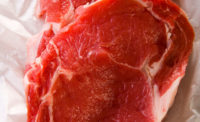On Aug. 20, 2015, the Food Safety and Inspection Service (FSIS) issued Directive 10,010.2 (http://bit.ly/regleg1115) to instruct inspection program personnel (IPP) on how to conduct STEC verification activities, other than sampling, for raw beef (including veal and not-ready-to eat beef). Although FSIS has issued a new directive, “the agency has not made fundamental changes to the approach IPP use when performing STEC verification activities.”
FSIS makes clear that adulterant STEC (E. coli O157:H7 and the six non-O157 STEC) is a food safety hazard in raw non-intact beef and in intact beef intended for non-intact use. That said, an establishment has flexibility to address this hazard through its HACCP plan, a pre-requisite program, its SSOPs, or a combination of these. Moreover, an establishment can determine its controls over E. coli O157:H7 would be effective for the non-O157 STEC, negating the need to have separate provisions for non-O157 STEC, “unless data such as multiple non-O157 STEC sample results indicate otherwise.”
System verification
• HAV: The IPP are to conduct Hazard Analysis Verification (HAV) when scheduled or directed. The directive includes a table identifying the eight steps the IPP can use in performing the task. In essence, the steps guide the IPP through the establishment’s HACCP plan to ensure the establishment can support its determinations as to whether STEC is a hazard reasonably likely to occur.
• HACCP Verification: The directive also provides the steps the IPP should consider in verifying the establishment’s HACCP system; specifically, whether the establishment is implementing its system. For example, if the establishment’s plan calls for product testing, is the establishment drawing the samples as specified, recording the results and taking appropriate action? This verification task includes reviewing whether the establishment takes corrective/preventive action following an STEC positive. The IPP are also to ensure the establishment complies with all requirements applicable to instructional/disclaimer statements.
Positive findings
If there is a positive STEC sample, either through agency or establishment testing, the IPP are to verify the establishment took appropriate actions, in accordance with its HACCP system, to meet the requirements in 9 CFR 417.3. This includes appropriate product disposition and documentation.
IPP are not to issue an NR for an establishment positive finding, but are to issue an NR “if the establishment fails to take the appropriate actions in accordance with its HACCP system to meet the requirements in 9 CFR 417.3.”
On non-O157 positives, the “IPP are not to expect the establishment to initiate a testing program for non-O157 STEC if it does not already have one at this time.” That said, the IPP are to verify that the establishment reassessed its HACCP system for non-O157 STEC or maintains support that its existing controls for E. coli O157:H7 effectively control or prevent non-O157 STEC.
If the establishment is testing trim or other raw ground components and never finds a positive or the establishment has multiple positives evidencing a potential systemic problem, the IPP are to notify the district office, which will schedule an EIAO review.
Instructional/disclaimer statements
The directive addresses IPP verification activities at establishments that use or receive instructional/disclaimer statements.
At the producing establishment, the IPP verify that the establishment has an approved label bearing the statements, the products are sent to a federally inspected establishment, and the establishment can document the receiving establishment is handling the product appropriately.
At the receiving establishment, the IPP verify that the establishment has addressed the use of the incoming product with a disclaimer statement in its HACCP plan and/or is following any instructional statements on incoming product and applying an adequate lethality.
If the IPP find the receiving establishment is not complying with the requirements, they are to issue an NR, take a regulatory control action on products that are labeled with these statements but which will not receive a lethality, and notify the district office.
In sum, the directive does not make fundamental changes in IPP verification activities. It does, however, provide a structured procedure for the IPP to use in conducting verification activities. Establishments would be well served to review the new verification procedures so they are ready for IPP verifications. NP







